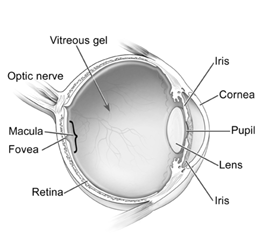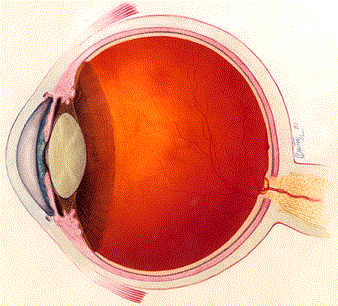Quick Look
Grade Level: 5 (3-5)
Time Required: 45 minutes
Expendable Cost/Group: US $0.00
Group Size: 2
Activity Dependency: None
Subject Areas: Biology
Summary
Students measure their own eyesight and calculate the average eyesight value for the class. They learn about technologies to enhance eyesight and how engineers play an important role in the development of these technologies.
Engineering Connection
Engineers have created eye devices for people who have vision difficulties, including glasses and LASIK (laser-assisted in situ keratomileusis) eye surgery equipment. Electrical engineers have applied their understanding of the eye to create microchips that can be implanted into the back of the eye. The microchip works as a light sensor for people whose natural light sensor does not work.
Learning Objectives
After this activity, students should be able to:
- Describe vision.
- Explain how vision is measured.
- List several technologies designed by engineers to adjust and enhance vision.
Educational Standards
Each TeachEngineering lesson or activity is correlated to one or more K-12 science,
technology, engineering or math (STEM) educational standards.
All 100,000+ K-12 STEM standards covered in TeachEngineering are collected, maintained and packaged by the Achievement Standards Network (ASN),
a project of D2L (www.achievementstandards.org).
In the ASN, standards are hierarchically structured: first by source; e.g., by state; within source by type; e.g., science or mathematics;
within type by subtype, then by grade, etc.
Each TeachEngineering lesson or activity is correlated to one or more K-12 science, technology, engineering or math (STEM) educational standards.
All 100,000+ K-12 STEM standards covered in TeachEngineering are collected, maintained and packaged by the Achievement Standards Network (ASN), a project of D2L (www.achievementstandards.org).
In the ASN, standards are hierarchically structured: first by source; e.g., by state; within source by type; e.g., science or mathematics; within type by subtype, then by grade, etc.
NGSS: Next Generation Science Standards - Science
-
CCC.8.3-5.8.
Engineers improve existing technologies or develop new ones to increase their benefits, to decrease known risks, and to meet societal demands.
(Grades 3 - 5)
More Details
Do you agree with this alignment?
-
DCI.PS4.B.3-5.3.
An object can be seen when light reflected from its surface enters the eyes.
(Grade 4)
More Details
Do you agree with this alignment?
-
SEP.7.3-5.4.
Make observations and/or measurements to produce data to serve as the basis for evidence for an explanation of a phenomenon.
(Grade 4)
More Details
Do you agree with this alignment?
Common Core State Standards - Math
-
Multiply and divide within 100.
(Grade
3)
More Details
Do you agree with this alignment?
-
Fluently add and subtract multi-digit whole numbers using the standard algorithm.
(Grade
4)
More Details
Do you agree with this alignment?
International Technology and Engineering Educators Association - Technology
-
Technological advances have made it possible to create new devices, to repair or replace certain parts of the body, and to provide a means for mobility.
(Grades
3 -
5)
More Details
Do you agree with this alignment?
-
Describe how a subsystem is a system that operates as part of another, larger system.
(Grades
3 -
5)
More Details
Do you agree with this alignment?
State Standards
Colorado - Math
-
Multiply and divide within 100.
(Grade
3)
More Details
Do you agree with this alignment?
-
Fluently add and subtract multi-digit whole numbers using standard algorithms.
(Grade
4)
More Details
Do you agree with this alignment?
Colorado - Science
-
Human body systems have basic structures, functions, and needs
(Grade
5)
More Details
Do you agree with this alignment?
Materials List
Each group needs:
- pencils, one per student
- calculator
- 20/20 Worksheet, one per student
For the entire class to share:
- Eye Chart
- 1 long piece of masking tape or blue tape
- tape measure, to measure a distance of 20 feet
Worksheets and Attachments
Visit [www.teachengineering.org/activities/view/cub_human_lesson06_activity1] to print or download.Introduction/Motivation
Our eyes are an important part of our nervous system. What do we do with our eyes? We see the world around us! Why do we have two eyes? Well, two eyes help us see a larger area than just one eye. Each of our eyes sees an object from slightly different angles, enabling our brains to fit two images together to make 3-D images in our heads. These 3-D images help us judge the distance we are from objects. Does everybody see the same? Well, everyone's eyes have lenses that change shape when we focus on something. The lenses become rounder when we look at something close up and flatter when we look at something that is far away. However, not all eyes focus light rays exactly the same. How your eyes see something is called vision.
What does it mean to have 20/20 vision? Do you know? (Listen to student ideas.) Having 20/20 vision means that when you stand 20 feet away from the classroom board, you can see what the "average" person sees. If you have 20/40 vision, it means that you can only read the letters that someone with 20/20 or "normal" vision can read standing 40 feet away. This means that you must be closer to the chalkboard to read it. Can you guess what having 20/100 vision means? It means that if you were standing 20 feet from the board you would see what an average person standing 100 feet away would see.
You can also have vision that is better than average. If you had 20/10 vision, you would be able to stand 20 feet from the classroom board and see what an average person sees when he is10 feet away from the chart. A hawk's vision is eight times better than a human's—that would be almost 20/2 vision!
The eye itself is a ball made up of three layers. The outside layer is made of two parts, the clear cornea (directly at the front of the eye) and the white sclera (gives the eyeball its shape). Beneath the outside layer is the middle layer, called the iris. The iris controls how much light enters the eye. It dilates to let more light in through the pupil and contracts to let in less light. The iris is pigmented and gives the eye its color. After light has passed through the cornea and iris (pupil), it is focused by the lens and continues to the retina, where the light becomes an image that is sent to the brain via the optical nerve. Figure 1 shows a diagram of the eye, including these components.
In an attempt to see at 20/20, some people use glasses or contact lenses. Also, some amazingi medical technologies have been developed with the help of engineers to correct vision. One example is LASIK surgery. LASIK stands for "laser-assisted in situ keratomileusis" and is a procedure that permanently changes the shape of the cornea (the clear part on the front of the eye) by using a laser. The top surface of the cornea is cut and rolled back, revealing the middle section of the cornea. The laser vaporizes a portion of the middle section to reshape it, and then the flap is returned to its normal location over the eye. The result is an eye with a shape closer to the eye shape of a person with 20/20 vision, and thus, improved eyesight!
Today, we are going to measure our own vision. We are also going to figure out the average vision of our entire class, and think about how engineers design creative technologies with vision in mind.
Procedure
Before the Activity
- Print out the Eye Chart and affix it to a classroom wall. Use a piece of tape to mark a spot on the floor that is 20 feet from the chart.
- Make copies of the 20/20 Worksheet, one per student.
With the Students
- Ask students what they think 20/20 vision means. Help them brainstorm ideas. Present the Introduction/Motivation section content.
- Explain to students that their job as engineers today is to determine the average or "normal" eyesight for the class and then design a technology that has the class eyesight average in mind. The average will be determiend by first measuring and recording the vision of everyone in the class.
- Have students take turns standing at the 20-foot mark and identifying the smallest row on the eye chart that they can read with their right eyes (cover up the left eyes), then the left eyes (cover up the right eyes), then with both eyes together. The small number to the left of the row represents the denominator of the fraction. For example, if the last readable row has a 30 next to it, the vision is 20/30. Note: If someone has glasses, they can try this experiment with their glasses both on and off. Remind students to record on their worksheets their vision ratings.
- Once each student has measurements for both eyes, have them find the average of the two eyes together, recording this on their worksheet. (Students can also compare this to the vision of both individual eyes. The results may or may not be the same.)
- Next, provide every student with the data for each person in the class. Do this by projectingi a summary sheet on an overhead transparency, or writing the ratings on the classroom board.
- Have students calculate the class average and write a paragraph explaining why they think designs could be based on the class average vision data.
- Have students share their answer with a neighbor and then see if the class can come to a consensus.
- With a neighbor, have students brainstorm and sketch (if time) a new technology for the class that is based on the vision data. Tell students that they are designing an electronic message board for the teacher to put up homework reminders, upcoming events for the school, and important class news. Have students think about the average vision of the class, and use that to decide what the message board will look like and where in the classroom it should be placed. Have students share their ideas with the rest of the class.
Assessment
Pre-Activity Assessment
Discussion Questions: Solicit, integrate and summarize student responses. Ask students:
- Why do we have two eyes instead of one?
- What is 20/20 vision?
Activity Embedded Assessment
Worksheet: Have students complete the 20/20 Worksheet. Review their answers to gauge their mastery of the concepts.
Voting: Ask a series of true/false question and have students vote by holding thumbs up for true and thumbs down for false. Tally the votes and write the numbers on the board. Give the right answer.
- True or False: Vision is how someone sees something. (Answer: True)
- True or False: Everyone's eyes have lenses that change shape when they focus on something. (Answer: True, the lenses of our eyes become rounder when we look at something close up and flatter when we look at something that is far away.)
- True or False: The "average" person can see 20/30 vision. (Answer: False, the average person sees with 20/20 vision.)
- True or False: The only way to correct vision is with glasses. (Answer: False, other technologies have been developed with the help of engineers to correct vision, such as LASIK eye surgery.)
Post-Activity Assessment
Class Presentation: Have student groups present their electronic message board design to the rest of the class. Ask them to discuss why they created the design as they did and where they would place the message board in the classroom.
Informal Discussion: Solicit, integrate and summarize student responses.
- Ask students to discuss why understanding vision and how the eye works is important to engineers.

Troubleshooting Tips
If you do not have 20 feet of space in front of the chart, have students read the chart from 10 feet away and then convert the fraction to 20 feet. For example, 10/40 would be 20/80.
Consider having one person record all of the data on the classroom board or overhead transparency for the rest of the class to view.
You may want to suggest to students alternate ways of finding a "normal" value for the class. The mean (the average), median (the value in the exact middle of the data set), and mode (the most often occurring measurement) are good places to start.
Activity Extensions
Not all animals have 20/20 vision. For example, hawks see eight times better than humans and frog eyes have cells that are especially sensitive to movement. Have students research how different animals "see."
Have students investigate the difference between nearsightedness and farsightedness.
Have students answer the question, "Is eating carrots good for your eyesight?" (Yes, it can be because carrots contain vitamin A, which is used to make pigments in the light-sensitive cells of the eye!)
Have students calculate their vision if the average is based on 100/100 vision. This is accomplished by multiplying the fraction by another fraction to get the numerator to 100. For example, if a person has 20/40 vision, multiply that number by 5/5 to get 100/200.
Subscribe
Get the inside scoop on all things TeachEngineering such as new site features, curriculum updates, video releases, and more by signing up for our newsletter!More Curriculum Like This

Students examine the structure and function of the human eye, learning some amazing features about our eyes, which provide us with sight and an understanding of our surroundings. Students also learn about some common eye problems and the biomedical devices and medical procedures that resolve or help...

Students learn about the function and components of the human nervous system, which helps them understand the purpose of our brains, spinal cords, nerves and five senses. In addition, how the nervous system is affected during spaceflight is also discussed.

Students are introduced to the Robotics Peripheral Vision Grand Challenge question. They are asked to write journal responses to the question and brainstorm what information they require in order to answer the question. Students draw a basis for the average peripheral vision of humans and then compa...

Students learn about the anatomical structure of the human eye and how humans see light, as well as some causes of color blindness. They conduct experiments as an example of research to gather information.
References
International Society for the Enhancement of Eyesight. Accessed January 28, 2005. http://www.i-see.org/
Copyright
© 2006 by Regents of the University of ColoradoContributors
Joe Freidrichsen; Denali Lander; Malinda Schaefer Zarske; Janet YowellSupporting Program
Integrated Teaching and Learning Program, College of Engineering and Applied Science, University of Colorado BoulderAcknowledgements
The contents of this digital library curriculum were developed under grants from the Fund for the Improvement of Postsecondary Education (FIPSE), U.S. Department of Education and National Science Foundation (GK-12 grant no. 0338326). However, these contents do not necessarily represent the policies of the DOE or NSF, and you should not assume endorsement by the federal government.
Last modified: March 12, 2022









User Comments & Tips